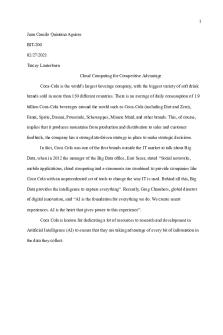Chapter 3 - Strategic Planning for Competitive Advantage PDF

| Title | Chapter 3 - Strategic Planning for Competitive Advantage |
|---|---|
| Course | Principles of Marketing |
| Institution | Ryerson University |
| Pages | 5 |
| File Size | 227.8 KB |
| File Type | |
| Total Downloads | 84 |
| Total Views | 157 |
Summary
Download Chapter 3 - Strategic Planning for Competitive Advantage PDF
Description
Chapter 3 - Strategic Planning for Competitive Advantage → Strategic Planning Leadership and Managerial Process: Organization’s objectives and resources + Evolving market opportunities = Strategic Planning 3 levels: 1. Corporate ● Sets the direction and scope - mission statement, business opportunities, and resource allocation 2. Business ● Takes place at the SBU level ● Goal is to gain a competitive advantage 3. Marketing ● Target market and marketing mix activities Decisions: ● Strategic ○ Made at all three levels ○ Wider in scope ○ Longer in orientation ○ Affect long-run course, allocation of resources, and financial success ●
Tactical ○ Made at the operational or marketing level ○ Narrow in scope ○ Short term ○ Limited impact of long-run profitability ○ Directed from strategic decisions made at the corporate level
→ Corporate Planning ● Defining the Business Mission ○ Foundation ○ What value do we provide for customers? ○ Establishes boundaries for all decisions Business Mission: Goods and Services Offered ≠ Focus = Markets to serve ● Shouldn't be focused on goods and services rather, should be focused on markets to serve
Designing the Business Portfolio: ● Starts with an understanding of the current environment and potential environment ● Conduct a SWOT Swot Analysis: ● Strengths ● Weaknesses ● Opportunities ● Threats ●
Strategic alternatives ○ SWOT analysis will result in themes that can take the form of alternative growth
Growth Strategies: ● Ansoff’s Strategic Opportunity Mix
● → Business Planning Business Planning for Competitive Advantage ● How to go about implementing and executing the strategy ○ More detailed planning at the SBU level ○ The goal is to achieve a competitive advantage that is sustainable ○ Complete a SWOT at the SBU level Competitive Advantage ● The set of unique features of a company and its products that are perceived by the target market as significant and superior to the competition ○ Cost ○ product/service differentiation ○ Niche strategies
Cost Competitive Advantage
●
●
Product/Service Differentiation Competitive Advantage Apple - competitive differentiation built around innovation Niche Competitive Advantage Serving the needs of a segment that has good growth potential but is not crucial to the success of the major competitors ○ Geographic niche ○ Product niche
Building a Sustainable Competitive Advantage ● An advantage that ○ Cannot be copied ○ Can be sustained ● Sources of tomorrow’s competitive advantages: ○ Skills and assets of the organization ○ Marketing leaders need to continually focus on these skills and assets to create and sustain the competitive advantage → Marketing Planning Selling Marketing Objectives: ● Statement of what is to be accomplished ○ Realistic ○ Measurable ○ Time Specific Target Market Strategy ● Begins with a MOA ○ Estimation of size and sales potential of segments that are of interest
●
Then a decision regarding which/how many segments to target
The Marketing Mix ● Product ● Place ● Promotion ● Price Product Strategies ● Heart of the marketing mix ○ The product offering and product strategy ○ Physical product or a service ■ Physical unit ■ Package ■ Warranty ■ After sale service ■ Brand name ■ Image ■ Value Pricing Strategies ● What a buyer must give up in exchange ○ “Value” in the mind of the consumer ○ Quickest element to change ○ Can be an important competitive weapon Place Strategies ● Making the products available when and where the customer wants them ○ Physical distribution ■ Storing ■ Transporting Promotion Strategies ● Introduce, facilitate, or sustain conversation and community between company and customer ○ Integrated marketing communications ■ Advertising ■ Direct marketing ■ Public relations ■ Sales promotion ■ Personal selling ■ Digital marketing
→ Implementation, Evaluation, and Control Implementation: ● The process that turns the plan into action - “doing what you said you were going to do” ● Can be a source of failure Evaluation and Control Evaluation - gauging → achievement of objectives Effective Strategic Planning ● Creativity ● Continual attention ● Management commitment
Marketing Audit
← Control - informal and formal control will create efficiency...
Similar Free PDFs

Competitive Advantage of Groupon
- 1 Pages

Apple competitive advantage
- 18 Pages

Mapping Competitive Advantage
- 6 Pages
Popular Institutions
- Tinajero National High School - Annex
- Politeknik Caltex Riau
- Yokohama City University
- SGT University
- University of Al-Qadisiyah
- Divine Word College of Vigan
- Techniek College Rotterdam
- Universidade de Santiago
- Universiti Teknologi MARA Cawangan Johor Kampus Pasir Gudang
- Poltekkes Kemenkes Yogyakarta
- Baguio City National High School
- Colegio san marcos
- preparatoria uno
- Centro de Bachillerato Tecnológico Industrial y de Servicios No. 107
- Dalian Maritime University
- Quang Trung Secondary School
- Colegio Tecnológico en Informática
- Corporación Regional de Educación Superior
- Grupo CEDVA
- Dar Al Uloom University
- Centro de Estudios Preuniversitarios de la Universidad Nacional de Ingeniería
- 上智大学
- Aakash International School, Nuna Majara
- San Felipe Neri Catholic School
- Kang Chiao International School - New Taipei City
- Misamis Occidental National High School
- Institución Educativa Escuela Normal Juan Ladrilleros
- Kolehiyo ng Pantukan
- Batanes State College
- Instituto Continental
- Sekolah Menengah Kejuruan Kesehatan Kaltara (Tarakan)
- Colegio de La Inmaculada Concepcion - Cebu












